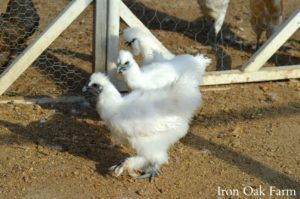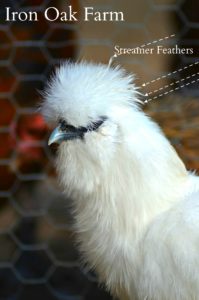 I’ve raised Silkies on and off throughout my chicken-keeping career. In that time I’ve ended up with a lot of roosters. Silkies, because they’re more of a pet chicken than a layer, are often sold in a straight run, meaning there is a 50/50 chance of getting a pullet or a cockerel. The reason I tend to get roosters is that I’m very bossy at the feed store, I want the plumpest, largest, most sturdy-looking chicks that the batch has to offer. And often those end up being males. When it comes to choosing chicks, I like to pick out my own. So I ask if I can just come behind the barricade and pick out my own from the brooder bins. If they say no, that an employee has to do it, then I become the annoying customer who points and yells “that one…no that one…yes by the food dish.” As the employee grabs back and forth at rushing chicks. But that’s who I am.
I’ve raised Silkies on and off throughout my chicken-keeping career. In that time I’ve ended up with a lot of roosters. Silkies, because they’re more of a pet chicken than a layer, are often sold in a straight run, meaning there is a 50/50 chance of getting a pullet or a cockerel. The reason I tend to get roosters is that I’m very bossy at the feed store, I want the plumpest, largest, most sturdy-looking chicks that the batch has to offer. And often those end up being males. When it comes to choosing chicks, I like to pick out my own. So I ask if I can just come behind the barricade and pick out my own from the brooder bins. If they say no, that an employee has to do it, then I become the annoying customer who points and yells “that one…no that one…yes by the food dish.” As the employee grabs back and forth at rushing chicks. But that’s who I am.
 It can be difficult to sex any chicken breed at a young age, but Silkies, in particular, are even more of a challenge because they mature slower than other breeds. The male and female also have similar coloring and plumage, particularly the crest plumage.
It can be difficult to sex any chicken breed at a young age, but Silkies, in particular, are even more of a challenge because they mature slower than other breeds. The male and female also have similar coloring and plumage, particularly the crest plumage.
I belong to several online SIlkie groups, and sexing is one of the most frustrating topics discussed with the breed. The good thing is that with a few tips, you don’t have to wait until your hens lay their first eggs or your cockerels start to crow to be certain, or at least have a good guess. While a trained eye might be able to spot a male from a female right from the first hatch, most other noticeable signs start presenting themselves around 6-9 weeks.
Below are 7 things to look for when trying to sex your Silkies.
Crest Feathers

Streamer feathers starting to show on a young male Silkie.
Both the male and female Silkie boast the fluffy crown of feathers on their head. When they are young this cotton ball shape may look very similar across the sexes. But around 7 weeks the male will start to develop “streamer feathers”. These are single feathers that extend beyond the fluffy crest. The female will keep her neat rounded crest into adulthood.
Wattle
Male Silkies will develop their wattle much sooner than females. It is easier to spot when you have a mixed flock of both pullets and cockerels of the same age. You will see that some are developing a wattle where others aren’t. These early wattles belong to the boys. Females will develop a wattle much later…closer to her laying her first egg.
Body Positioning
 Female Silkies will keep their bodies more horizontally positioned, where males will stand more upright, keeping their chests forward and their necks elongated. Males will also hold their tail more upright, where females will keep it horizontal or slightly dipped toward the ground. Cockerels of the same age and color will be larger overall.
Female Silkies will keep their bodies more horizontally positioned, where males will stand more upright, keeping their chests forward and their necks elongated. Males will also hold their tail more upright, where females will keep it horizontal or slightly dipped toward the ground. Cockerels of the same age and color will be larger overall.
Wings
This is the one method that can be used early on in chicks that are less than a week old. In females, you will see just the tiniest little suggestion of primary wing feathers at the tip of the wing. In males, it remains as fluff until they are a bit older.
Comb
In females, the comb comes in in a more delicate “V” shape, where the male has a wider “U” shape.
Feet

This female has very little feathering on her feet compared to her male brother.
Males have larger feet, thicker legs, and longer hackle feathers than females.
Personality
While I’ve seen dominant personalities in both hens and roosters, in general, cockerels tend to be more bossy, louder, have tendencies to lead or show food, they may bite, and show curiosity earlier than pullets.
If all else fails there are blood tests that can be performed to sex your chickens.













15 Comments
I have two silkies, hatched by broody hens. hatched the beginning of August. lots of questions – when do they lay eggs? can they cross breed with others types of chickens? How do I sex them, one is accepting to being held, the other not so much. Crowns and beaks look the same more “U” shaped on beak i think. one is out going the other hides they still hand out together, can a male silk fertilize a non silkie
You can also tell by the beak colour. Females have a green colour. Males have a blue colour.
Trying to sex my two is more confusing now lol both still have big bushy head of features. My white one has big round bushes tail and stands tail, my gray has thin long tail features and sits in my lap the white one has a bigger beck, and is slightly bigger, they are about 5 months old and just started getting their adult features.
Hi. How do you go about blood testing your chicks to see if they are male or female? Thank u
Hi i got two baby silkies and I’m hoping there hen’s I’m not shour how to tell if there boys or girl’s there about 4 weeks old.?
Here’s an article that may help.
https://americansilkiebantamclub.org/pages/sexing-silkies
Hi i have a white silkie who has developed a red cere..the other 2 whites do not….is this a male????
So I ordered 10 day old bantam silkies at the end of April. 1, the don’t didn’t make it but the other 9 did. I had 4 I was pretty positive were males. They are all very friendly but these 4 were bigger than the others of the same color, they walked like roosters from about 3 weeks old, some had lots of leg feathers and overall just seemed to act like roosters. Well I paid to get all 9 of them DNA tested and they all came back as female. I’m just not buying it. The brown and black ones always had a lot of leg feathers, but there are drastic differences in size. I also have 4 white ones. 2 are double the size of the other 2 and the 2 big ones also have a ton of leg feathers. I’m so confused and feel like I’m back where I started minus the money I paid for sexing.
Hey thanks that was very helpful.
I just wanted to say thank you!!! This was by far the most helpful detailed information concerning sexing the silkies!! Great job!
Have a Fluffy Day!
Looking for a Silkie Chicken to buy
You might try Stromberg’s hatchery https://www.strombergschickens.com for small batches of birds
or Hoover’s Hatchery https://www.hoovershatchery.com for larger batches of birds (25 or more).
You can also try Cackle Hatchery https://www.cacklehatchery.com
or Murray McMurray https://www.mcmurrayhatchery.com
or My Pet Chicken https://www.mypetchicken.com
I need help!!! Soo this last chick season I got carried away and got to many chicks so five turned out to be roosters. The thing is I was able to tell they where Roos even before they started to grow combs. Everything about each of them even though they where all sweet in character you could tell it was a boy. Unfortunately I had to give them away. After the last three where rehomed 3 days later I heard a oooooh ooooh. It didn’t sound like any chicken I’ve ever hear. And one of the 5 boys I had was also a silkie. They crowed like chickens. At first I thought it was an owl it even sounded like the same register. Do days later I heard it again but I was outside. And was able to get there in time. It was coming from inside the coup. I looked and it was the little black silkie it was lifting its head like a roo and making that sound. But it was almost like a coo. I hear this sound every 3 to 4 days for less than 2 minutes in the middle of the day. The thing is even though it’s close to 6 months it’s about the size of month old chick. It runs with the pack well and has never bit anyone. It hasn’t shown any signs of male behavior compared to the 5 we had. It doesn’t even have a comb or wattles just a bump on the head where one should be, even the last silkie that I’m 90% sure has is a female has a comb and wattles. Can hens cooo like owls? I don’t think I’ve even seen it try to mate anything.
Is there any chance that you may have gotten a bantam?
Hens can crow too.